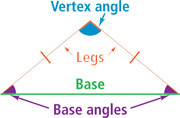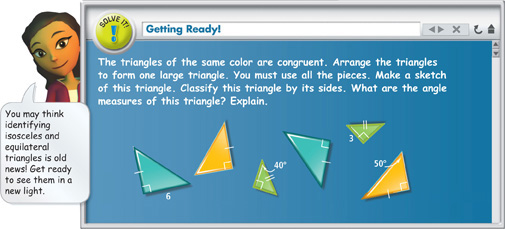4-5 Isosceles and Equilateral Triangles
Objective
To use and apply properties of isosceles and equilateral triangles
 Dynamic Activity
Dynamic Activity
Isosceles and Equilateral Triangles
 Lesson Vocabulary
Lesson Vocabulary
- legs of an isosceles triangle
- base of an isosceles triangle
- vertex angle of an isosceles triangle
- base angles of an isosceles triangle
- corollary
In the Solve It, you classified a triangle based on the lengths of its sides. You can also identify certain triangles based on information about their angles. In this lesson, you will learn how to use and apply properties of isosceles and equilateral triangles.
Essential Understanding The angles and sides of isosceles and equilateral triangles have special relationships.
Isosceles triangles are common in the real world. You can frequently see them in structures such as bridges and buildings, as well as in art and design. The congruent sides of an isosceles triangle are its legs. The third side is the base. The two congruent legs form the vertex angle. The other two angles are the base angles.

Take note Theorem 4-3: Isosceles Triangle Theorem
Theorem
If two sides of a triangle are congruent, then the angles opposite those sides are congruent.
If …

Then …

Table of Contents
- 6-1 The Polygon Angle-Sum Theorems
- 6-2 Properties of Parallelograms
- 6-3 Proving That a Quadrilateral Is a Parallelogram
- 6-4 Properties of Rhombuses, Rectangles, and Squares
- 6-5 Conditions for Rhombuses, Rectangles, and Squares
- 6-6 Trapezoids and Kites
- 6-7 Polygons in the Coordinate Plane
- 6-8 and 6-9 Coordinate Geometry and Coordinate Proofs





